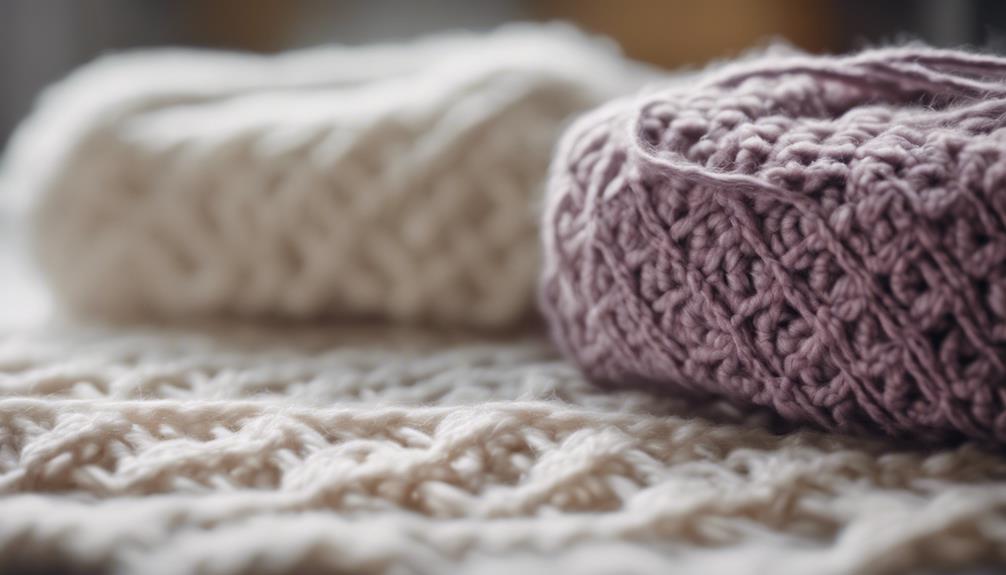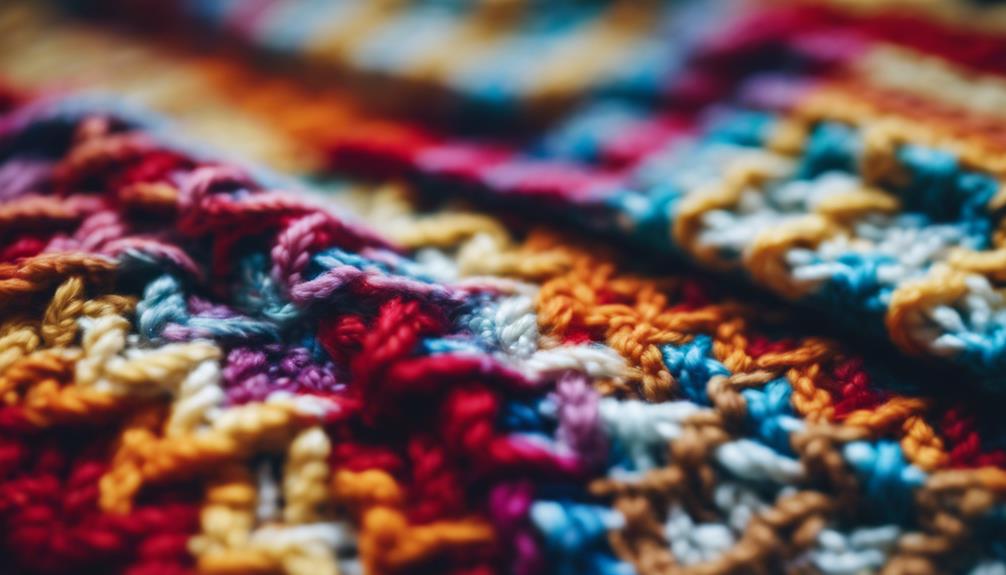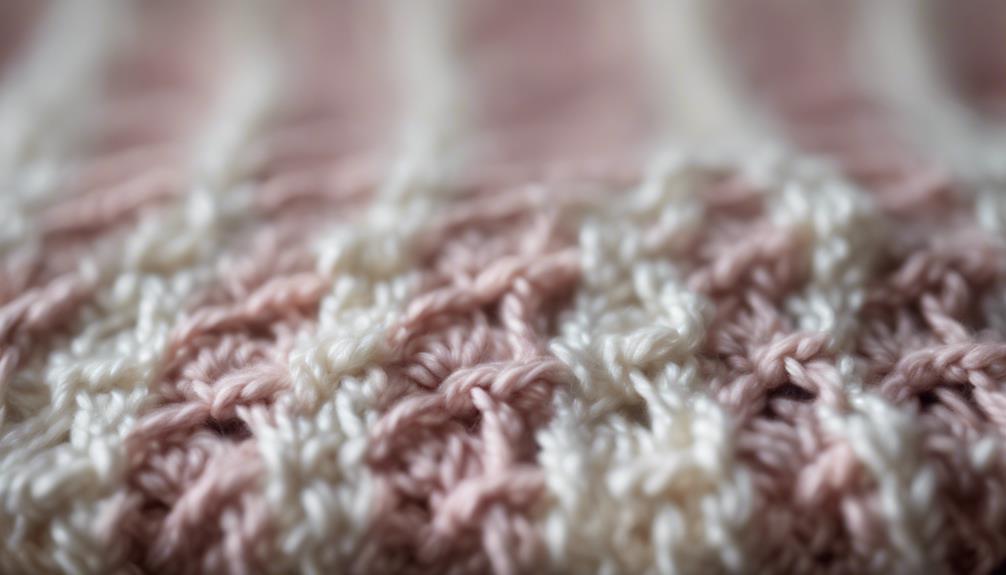Crocheting a blanket can be a time-consuming process, influenced by factors like the complexity of patterns, yarn weight, skill level, and stitch intricacy. Using thicker yarns such as bulky or super bulky can speed up the project by requiring fewer stitches per row, while intricate designs like cables and lacework may prolong completion. Stitches like cables, bobbles, and shells can slow down the process. To increase speed, consider using simpler stitches like double crochet, larger hooks for bigger stitches, and maintaining consistent tension. Having a good understanding of these factors can help in managing expectations for your crochet blanket projects.
Key Takeaways
- Yarn weight affects the number of stitches and project speed.
- Complex patterns with intricate stitches increase crocheting time.
- Skill level and familiarity with stitches impact crocheting speed.
- Larger crochet hooks and consistent tension can expedite the process.
- Choosing simpler designs and repetitive motifs can speed up blanket creation.
Factors Affecting Crochet Blanket Timelines

When crocheting a blanket, the time it takes to complete can be affected by various factors. The importance of the pattern chosen plays a significant role in determining how long it will take to finish the blanket. Intricate patterns with many details and changes in stitches can slow down the crocheting process compared to simpler designs. Additionally, the complexity of the stitch used in the pattern can also impact completion time. Complex stitches that require more attention and precision will naturally take longer to crochet.
Moreover, the crocheter's skill level is vital in determining the speed at which a blanket can be completed. Beginners may take longer to finish a project compared to experienced crocheters due to the learning curve associated with new techniques. Additionally, factors such as yarn weight, hook size, and time availability all contribute to the overall completion time of a crochet blanket. By considering these elements carefully, crocheters can plan their projects effectively and estimate the time needed to finish each blanket.
Impact of Yarn Weight on Speed

Thicker yarn greatly speeds up the completion of crochet blankets by requiring fewer stitches per row. Bulky yarns cover more surface area, reducing the overall time spent crocheting each row. On the other hand, lighter weight yarns demand more stitches and intricate work, leading to a longer project duration. Chunky yarns, being thicker, create a cozy and warm blanket quicker than finer yarn options. The weight of the yarn directly impacts the speed at which a blanket can be crocheted, affecting the overall time required for completion.
| Yarn Weight | Crochet Speed | Project Duration |
|---|---|---|
| Bulky Yarn | Faster completion | Shorter |
| Lighter Weight | Slower progress | Longer |
| Chunky Yarn | Quick results | Cozy finish |
Influence of Pattern Complexity

Moving from the impact of yarn weight on speed, the complexity of crochet patterns greatly influences the time required to complete a blanket. When tackling a crochet blanket pattern that involves advanced techniques, intricate designs, and detailed instructions, the time investment naturally increases.
These complex patterns often incorporate stitch variations, color changes, and unique textures, all of which contribute to the intricacy and lengthen the crocheting process. Additionally, patterns with shaping techniques, such as curves, corners, and elaborate borders, demand precision and attention to detail, further slowing down the project completion time.
Advanced techniques like cables, lacework, and intricate motifs add another layer of complexity, making the crocheting process more involved and time-consuming. Hence, the level of intricacy and detail within a crochet blanket pattern plays a significant role in determining the amount of time it will take to finish the project.
Time-Consuming Crochet Stitches

Utilizing intricate crochet stitches like cable, popcorn, and shell patterns impacts the pace of crocheting a blanket due to their complexity and multiple steps involved. These time-consuming stitch patterns, such as bobbles, clusters, and puff stitches, require creating additional loops and layers, extending the time needed to complete a project.
Detailed stitch combinations like star stitch, crocodile stitch, and basketweave demand precision and concentration, further slowing down the crocheting process. In addition, intricate stitch patterns such as lace, broomstick lace, and waffle stitch involve complex designs with varying stitch heights and structures, leading to a slower crocheting pace.
Advanced stitch techniques like tapestry crochet, Tunisian crochet, and filet crochet necessitate careful color changes, special hook manipulation, and specific stitch placements, all contributing to the lengthier time required to crochet a blanket. Even when working on a smaller project like a Baby size blanket, using these time-consuming crochet stitches can make the task more challenging and time-intensive, especially if attempted with a flimsy crochet hook.
Strategies to Improve Crocheting Speed

To enhance crocheting speed when working on blankets, we can consider various strategies that optimize efficiency without compromising on quality. When aiming for a quicker project, choosing bulky or super bulky yarn can greatly reduce the number of stitches required, expediting the process.
Opting for simple crochet stitches like the double crochet stitch over intricate ones maintains quality while saving time. Additionally, selecting quick and easy crochet blanket patterns with repetitive motifs can speed up the crafting process.
Using larger crochet hook sizes, such as 6mm or above, helps work through projects faster by creating larger stitches. Consistent tension and developing a rhythmic crocheting motion also contribute to completing a crochet blanket more swiftly.
Frequently Asked Questions
How Long on Average Does It Take to Crochet a Blanket?
On average, it takes about 1 month to crochet a blanket. Most crocheters finish a baby blanket within this timeframe, with only a small percentage taking more than 6 months.
Some speedy crafters manage to complete a blanket in less than 7 days, showcasing impressive skills. So, the time investment in crocheting a blanket varies, but the average completion time hovers around a month, according to statistics.
Can You Crochet a Blanket in a Day?
Yes, we can crochet a blanket in a day if it's a small baby blanket. Larger blankets, however, usually require more time. Factors like size, complexity, yarn weight, and skill level influence the time needed.
It's important to pace ourselves and take breaks to avoid fatigue. While a one-day blanket project is possible for smaller sizes, most crocheters spread their work over several sessions for larger projects.
Why Can't I Crochet Fast?
We can't crochet fast due to various factors. Yarn thickness and hook size impact speed. Weak hooks break easily, slowing us down.
Complex stitches and patterns take more time to complete. Intricate projects with many details also slow down crocheting.
To speed up, use appropriate tools, choose simpler patterns, and practice regularly. With patience and practice, crocheting speed can improve over time.
How Long Does It Take to Hand Crochet a Blanket?
Crocheting a blanket's duration varies based on size, complexity, and skill level. A baby blanket typically takes about a month, while adult-sized afghans might require several months due to their larger size.
Factors like yarn weight, pattern difficulty, and available time influence completion time. Advanced crocheters finish faster due to their expertise.
What Factors Contribute to the Length of Time it Takes to Crochet a Blanket?
The length of time it takes to crochet a throw blanket depends on factors like the size of the blanket, the complexity of the pattern, and the crocheter’s speed and experience. Larger blankets with intricate designs may take longer to complete than smaller, simpler ones.
Conclusion
To sum up, the time it takes to crochet a blanket is influenced by various factors such as yarn weight, pattern complexity, and the type of stitches used. On average, it can take around 40-50 hours to complete a standard-sized blanket.
However, with practice and efficient techniques, crocheters can improve their speed and reduce this time considerably. So, next time you start a crochet project, remember that patience and practice can lead to faster results!










